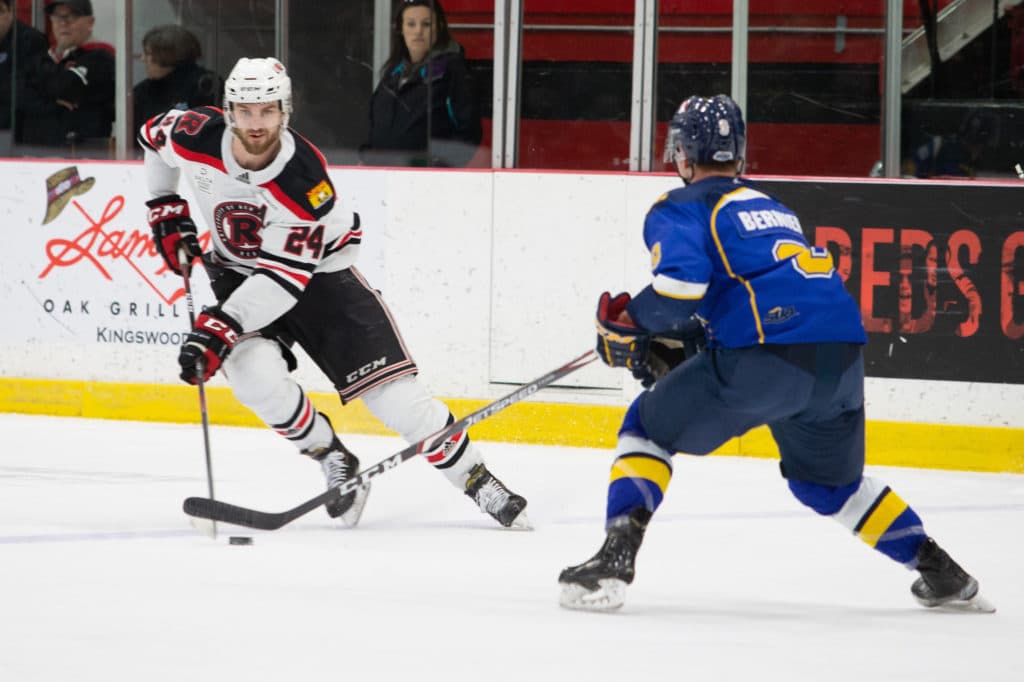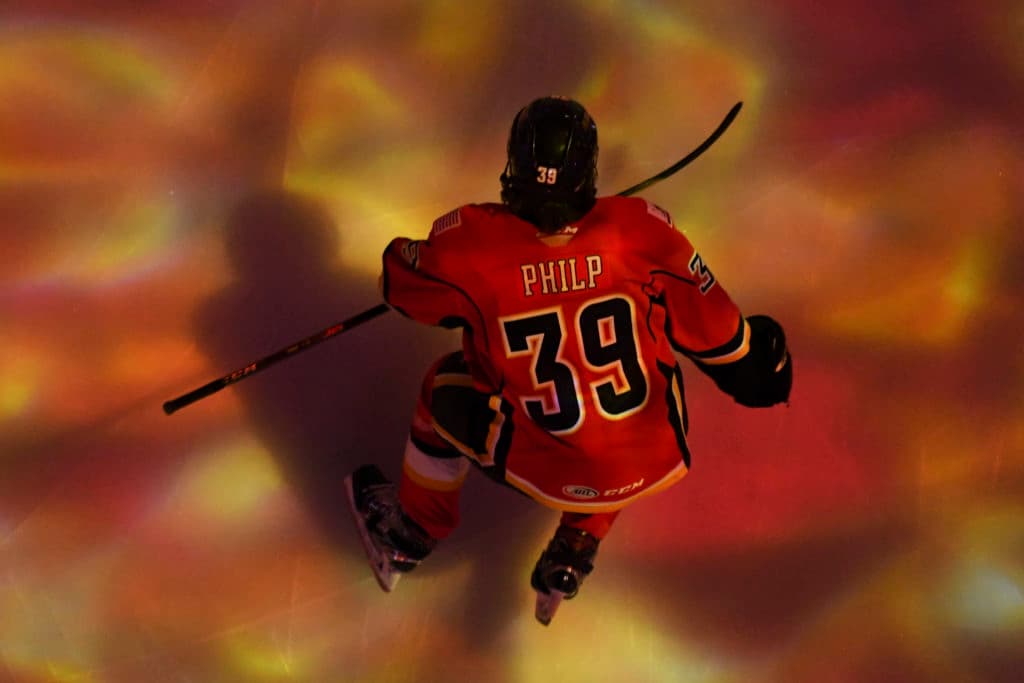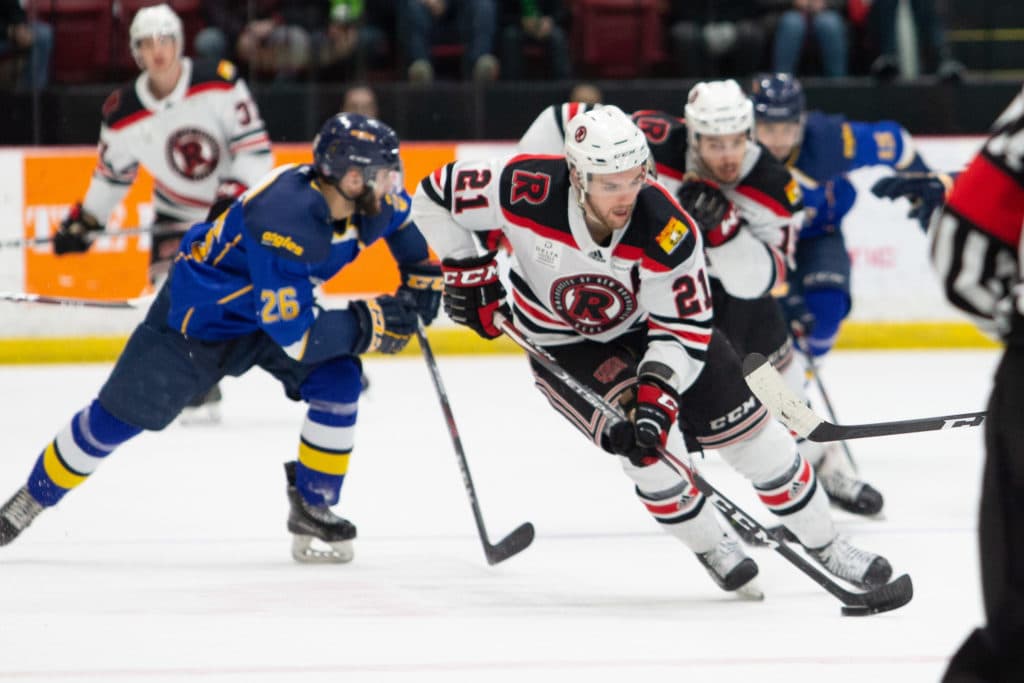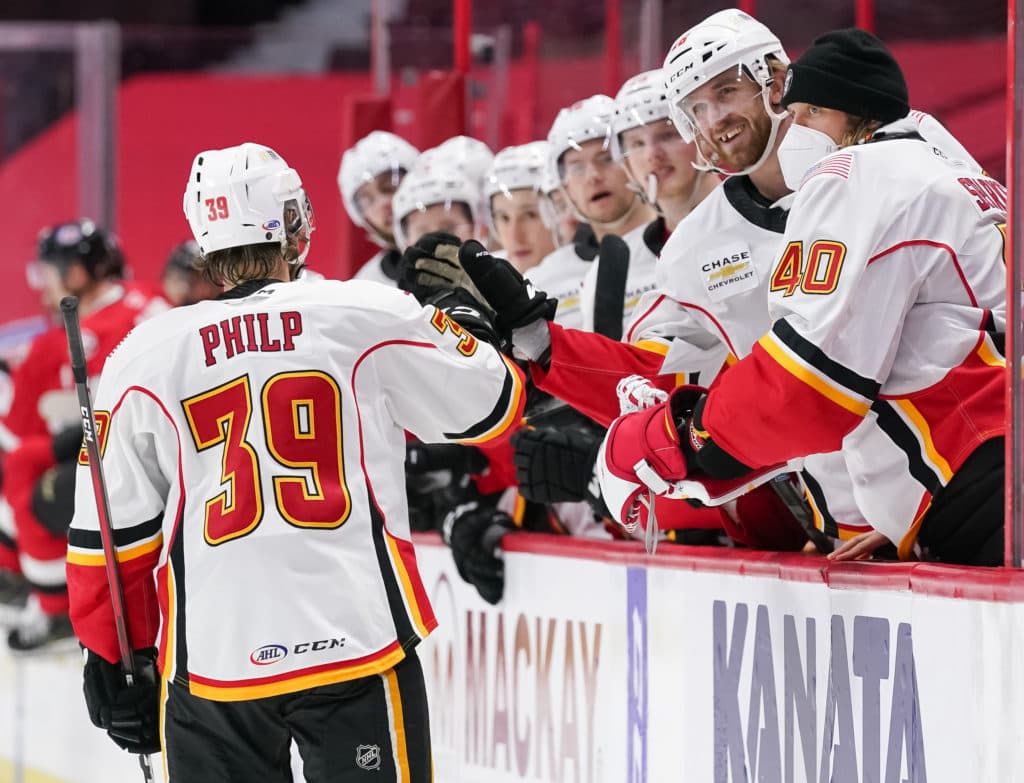Nice tip by Simpson, fresh off a four-year tenure with the U. of New Brunswick. #AHLHeat lead 2-1 off the big centre's first pro goal.
Nation Sites
The Nation Network
FlamesNation has no direct affiliation to the Calgary Flames, Calgary Sports and Entertainment, NHL, or NHLPA
How important has U Sports hockey become in facilitating player development?

Photo credit: James West/UNB Athletics (Bennett, Dove-McFalls, Simpson); Jesse Harsen/Stockton Heat (Philp). Graphic by Mike Gould
By Mike Gould
Apr 27, 2021, 12:00 EDTUpdated: May 9, 2021, 02:07 EDT
First-year Stockton Heat forward Mark Simpson scored his first two American Hockey League goals in a game against the Toronto Marlies on Feb. 26, 2021.
His first professional tally came late in the first period of that contest. Simpson was able to use his stick to cleanly deflect a long shot by defenseman Zac Leslie past Marlies goaltender Andrew D’Agostini.
The goal would eventually stand as the game-winning marker in a decisive 8-1 Heat victory on Scotiabank Saddledome ice.
By the time Simpson beat D’Agostini again—just 14 seconds before the halfway mark of the second period—the Heat already led 5-1 and were out-shooting the Marlies by a 20-6 margin.
Despite Simpson’s second goal being less relevant to the outcome of the game, it took on a different kind of significance. It represented a collaboration between two players who took drastically different paths to reach the AHL.
Connor Zary registered the primary assist on the play. He carried the puck around the circumference of the offensive zone before hitting Simpson’s tape with a hard, accurate pass towards the slot.
All Simpson had to do was receive the puck cleanly and fire it without hitting D’Agostini squarely in the pad. He succeeded on both counts.
Zary is widely regarded as one of hockey’s most promising prospects.
The Calgary Flames selected Zary in the first round of the 2020 NHL Entry Draft. In the 2019-20 campaign, he scored 38 goals and 86 points in 57 Western Hockey League games with the Kamloops Blazers. Zary has 22 points in 13 games for Kamloops this season as a 19-year-old.
Simpson was never drafted into the NHL. In 2012, the Moncton Wildcats selected him in the ninth round (155th overall) of the Quebec Major Junior Hockey League Entry Draft. He only made his debut as a full-timer in the QMJHL during the 2013-14 season, as an 18-year-old.
The NHL Central Scouting Bureau only ranked Simpson as the 160th-best North American skater available to be selected in advance of the 2015 NHL Entry Draft, by which point he was already 20 and had already been passed over in the previous two years.
With no NHL team willing to secure his rights and few professional options at his disposal, Simpson opted to go down a path relatively unfamiliar for an aspiring professional hockey player but common for a 21-year-old born a stone’s throw from Saint John.
He went to the University of New Brunswick.

UNB Reds forward Mark Simpson (24) carries the puck into the offensive zone in a game against the Moncton Aigles Blues at the Aitken University Centre during the 2018-19 season. Photo credit: James West/UNB Athletics.
“UNB was always my goal in junior. I grew up in New Brunswick, obviously,” said Simpson. “I knew that I had to be a good player in the [QMJHL] in order to get noticed by UNB because [it’s] such a great program.
“My aspirations were always to do what I could to get to UNB,” Simpson added. “When that opportunity presented itself after my 20-year-old season, I jumped all over it.”
Many successful hockey players graduate out of the NCAA ranks in the United States. Very few players from the Canadian university ranks—officially called “U Sports”—make the NHL.
It’s not unheard of. Former Washington Capitals sniper Mike Ridley first turned heads at the University of Manitoba in the mid-1980s. Five-time Stanley Cup champion-turned-family physician Randy Gregg played four seasons at the University of Alberta in the 1970s and now has a U Sports award named in his honour.
Joel Ward, Steve Rucchin, Cory Cross, P.J. Stock, Stu Grimson, and current Flames centre Derek Ryan rank among the finest graduates from Canadian university hockey. But they’re few and far between, compared to the hundreds—if not thousands—of notable alumni from NCAA programs from across America.
The 2020-21 Stockton Heat would beg to differ with that trend. This year’s squad boasts three U Sports graduates—two from the UNB Reds, one from the University of Alberta—who have all made their presences felt in a positive way as part of the team’s forward group.
Luke Philp played three seasons out of Edmonton’s Clare Drake Arena between 2016-17 and 2018-19, being named the U Sports Player of the Year in his final year with Alberta before signing a two-year deal with the Flames.

Stockton Heat forward Luke Philp (39), previously of the Alberta Golden Bears, skates onto the Scotiabank Saddledome ice before a game in the 2020-21 AHL season. Photo credit: Candice Ward/Stockton Heat.
In Philp’s last game as an amateur, his Golden Bears faced off against the Reds for the 2019 U Sports University Cup. Only 10 minutes into the first period, Philp suffered a high-ankle sprain which ultimately sidelined him for the entire game.
Despite ultimately being named as a tournament all-star, Philp failed to come away with the main prize. The Reds won 4-2, with Simpson assisting on the eventual game-winning goal by fellow 2020-21 Heat rookie Kris Bennett.
Philp joined the Heat in 2019-20, tying for the team lead with 19 goals in his first year. Former adversaries Bennett and Simpson both joined him in the Stockton locker room this season.
Perhaps, initially, there was some lingering resentment over the outcome of that heavily-contested championship game?
“I figured that one might come up,” said Philp, with a smile. “Yeah, we’ve talked about it. I’ve talked with both these guys about it, congratulating them. They were well-deserving. It was unfortunate for me, I got injured early in the game. Don’t want to say things might’ve been different, but, they definitely deserved to win, they had a great team that year. It was tough watching, being hurt.
“We’ve talked about it a little bit, those guys shared a few stories, what they did, and stuff like that. We had won the year prior,” Philp added. “When I saw we had signed [Simpson], at first, and then Simmer told me [Bennett] was gonna come, too, I was pretty pumped because I’d played with those guys, both of them, at the U Sports All-Star Game, I guess you could call it, where we played the World Junior guys.”
Bennett also earned a spot on the 2019 University Cup all-star team and led the Reds with 47 goals and 113 points in 89 games since the start of the 2017-18 U Sports season.
Unlike Simpson, who wrapped up his full four-year U Sports tenure following the 2019-20 campaign and joined Stockton on a one-year AHL deal last October, Bennett only agreed to terms with the Heat on Mar. 13 and has played just nine games this season.
Bennett still had one more year of eligibility with the Reds but, with the Atlantic University Sport season in doubt, he opted to make the jump and follow Simpson to Stockton on a try-out.
“I was preparing pretty hard at New Brunswick, at the University of New Brunswick, with the team there, obviously expecting to play this year,” said Bennett. “We were working hard all season, playing a lot of exhibition games, scrimmages.
“After the Christmas break, after the New Year’s, I wasn’t really too sure what my next steps were with the University of New Brunswick,” Bennett added. “I kind of just started looking around and I’m fortunate and grateful that Stockton was able to bring me in.”

UNB Reds forward Kris Bennett (21) skates with the puck in a game against the Moncton Aigles Blues at the Aitken University Centre during the 2018-19 season. Photo credit: James West/UNB Athletics.
Stockton’s 30-game schedule for 2020-21 might initially resemble a typical truncated season for a university or collegiate team. While the on-ice action might be similar, the overall workload couldn’t be more different.
It’s been a major grind for the Heat to fit 30 games into 10 weeks. For contrast, a typical academic hockey program schedules its games exclusively on weekends to accommodate for travel time and class schedules.
Even so, for Simpson and Bennett, weekdays typically offered the best opportunities for training and growth at UNB.
“In the pro hockey world, you don’t hear much about the university sports in Canada,” said Bennett. “I think it’s a great pathway to further develop yourself as a person and as a hockey player. Especially at UNB, the practices we have there, we work out every week. You’re only playing on the weekends, it’s only a 30-game schedule, so you have so much time to develop.”
Gardiner MacDougall has captained the ship at UNB since the 2000-01 season, earning seven national championships and two U Sports head coach of the year honours along the way.
The 61-year-old Prince Edward Islander has won over 500 games with the Reds and has been an instrumental figure in establishing UNB as an institution for up-and-coming hockey players in Atlantic Canada.
The university’s V-Red Prospects hockey development program has attracted the likes of Gabriel Landeskog, Sean Couturier, Conor Garland, Brandon Saad, Jaden Schwartz, Jake Allen, Kevin Hayes, Bryan Rust, Alex Killorn, MacKenzie Weegar, Drake Batherson, and former Flames forward Garnet Hathaway.
Over 100 V-Red graduates have reached the AHL. 34 have cracked the NHL.
“I’ve known Gardiner since I was a little kid,” said Simpson. “I went through all his camps growing up. We had the UNB guys run those camps when I was a kid, so, it was kind of cool to go to school, eventually, there and have him as a coach. He brings that same passion he did when I was a kid.
“He gets so much out of players. With the shortened schedule—we only play 30 games—in our practices, we battle so hard all week. I think it translates to those games, and that’s why we’ve been so successful over the years. We’re such a well-conditioned team.”
As the Reds have risen over the past two decades, so has U Sports’ profile as a legitimate pathway leading to the NHL. Heat head coach Cail MacLean voiced his like-mindedness with MacDougall about Canadian university hockey increasingly resembling a second major junior league for late-blooming or underestimated amateurs.
“It’s extending the runway for take-off for these young players,” said MacLean. “What [U Sports] is doing is taking a Mark Simpson or a Kris Bennett or a Luke Philp and saying, they might not have shown enough to the scout’s eye to be able to get that opportunity early. But, now, with U Sports, it sort of extends the runway, they build character, they add more to their life as a whole.
“It allows them to grow, and now they’re getting that second look after more maturation,” MacLean added. “Players who are dedicated, like these guys are, and who work, and are honest in terms of their effort at getting better are able to be rewarded.”
“From a development aspect, there’s a better hockey pedigree of players coming to U Sports nowadays,” said MacDougall. “I look back when I started, in 2000, more of the major junior, specifically, [graduates] would probably give minor pro a crack, first, over school.”
MacDougall estimated Junior “A” alumni—graduates from leagues like the AJHL or OJHL—made up roughly 40 to 50 percent of his earlier UNB squads, with the remainder coming from major junior leagues like the WHL and OHL.
“The Junior “A” players, a lot of them relished and thrived at this level, but they’d get an opportunity to get to the [ECHL] and they thought that was terrific,” said MacDougall. “Away they’d go.
“We started to change,” MacDougall added. “The major junior guys, once they made the commitment to come to school, they were in it usually for the duration. They’d get their degrees, and then they’d move on to the pro level.”
Sophomore Reds forward Sam Dove-McFalls had multiple brushes with NHL developmental programs before he ever turned to the academic route.
Drafted 98th overall by the Philadelphia Flyers in the 2015 NHL Entry Draft, Dove-McFalls ultimately went unsigned following two more seasons in the QMJHL. He subsequently attended the Flames’ 2017 summer development camp.

UNB Reds forward Sam Dove-McFalls (15) surveys the ice while controlling the puck in a game against the Moncton Aigles Blues at the Aitken University Centre in the 2018-19 season. Photo credit: James West/UNB Athletics.
“I felt a lot more comfortable after having been to pro camps before,” said Dove-McFalls. “A lot less nervous, felt more confident, and it was just kind of nice just to experience a different NHL organization, different training camp. Everyone’s just a little bit different. Honestly, I really loved the city of Calgary, it was a beautiful spot, got to go to the Stampede one night. It was a fun experience.”
However, Dove-McFalls’ draft pedigree and solid QMJHL production translated to little in the way of professional offers.
“It was mostly East Coast League offers that I had coming out of junior,” said Dove-McFalls. “To be honest, I spoke to some guys who were in professional minor leagues and it didn’t sound like something I was ready for, right away. I didn’t want to do that, right away, and the program we have at UNB is second-to-none.
“I was blown away when I went on my recruiting trip,” he added. “With the way things are run here, it ended up being a pretty easy choice.”
MacDougall said he has noticed a trend of U Sports beginning to attract more players with few desirable professional options, particuarly in the last decade.
“The big difference there is, one, a chance to get your university degree, which is going to be with you long after your hockey career is finished,” MacDougall said. “Then, number two, they have a chance to develop and still have the dream of playing at a good level of pro hockey.”
Dove-McFalls has certainly developed. He established himself as an excellent U Sports player in the 2019-20 season, posting 26 points (nine goals, 17 assists) in 30 games as a 22-year-old sophomore.
Even with the 2020-21 campaign lost to the COVID-19 pandemic, Dove-McFalls and his teammates continued to train and develop under MacDougall’s watchful eye.
“I’ve never had a coach who pushes you the way he does,” said Dove-McFalls. ” It’s amazing, the pace and intensity that we practice at every day is unbelievable. He’s a big part of that. He brings his energy and he’s a really enthusiastic guy.
“He’s really good for us and I feel like I’ve improved a lot in my three years here at UNB,” Dove-McFalls added.
In a few years, Dove-McFalls might be able to replicate the impacts made by Philp, Simpson, or Bennett at the professional level. All three players have proven to be useful for the Heat this season, albeit playing in very different roles.
“They have a very good league,” said Heat defenseman Zac Leslie, who made the jump directly from the OHL to the AHL in 2015. “They come out of school older, stronger, and ready for the pro ranks.
“Going to school like Philper did, and like Simmer did, and like Benny did, it gives them that opportunity to continue to develop their game,” Leslie added. “And, obviously, especially the schools they go to.”
Bennett has suited up for nine games with Stockton since joining the team mid-season, tallying two assists in that span. His coach and teammates describe him as a relentlessly energetic player who establishes his presence on the ice with every shift he takes.
Simpson has been a regular in Stockton’s bottom-six all season long, playing in 22 of the team’s first 28 games and nailing down a regular role on the team’s penalty-killing corps. His 6’6″ frame has accelerated his acclimation to the ever-physical AHL game.
Philp, meanwhile, is the only member of Stockton’s U Sports trio with an NHL contract. The 25-year-old is a versatile two-way player who can slot in at all three forward positions and contribute on both special teams. He ranks third on the Heat with eight goals and 16 points in 28 games this year.

Stockton Heat forward Luke Philp (39) high-fives Mark Simpson after scoring a goal in a game at the Canadian Tire Centre during the 2020-21 AHL season. Photo courtesy of the Stockton Heat.
While Dove-McFalls can aim to emulate Bennett, Simpson, or Philp’s trajectories, Stockton’s three U Sports players can all look at Philippe Maillet as the most recent instance of an alumnus battling through multiple levels of adversity to eventually crack the NHL.
Despite only being taken in the seventh round of the 2009 QMJHL Entry Draft, the 5’10” Maillet managed to exceed expectations and became the leading scorer of the Victoriaville Tigres in his final season.
From there, Maillet committed to UNB and kicked off his four-year academic career in 2013-14. Instead of potentially toiling away at the lower levels of professional hockey—many of which still feature pure enforcers, often creating disadvantages for younger, smaller players—Maillet emerged as a star for the Reds and won two national championships.
After his illustrious U Sports career ended in 2017, Maillet joined the AHL’s Ontario Reign as a more mature 24-year-old with four full years of vigorous training under his belt. He transitioned seamlessly to the professional level and, at age 26, eventually signed a two-year NHL deal with the Washington Capitals in 2019.
Now 28, Maillet earned his first NHL game this season and currently leads the Hershey Bears with a 1.44 points-per-game rate (13 points in nine games).
“Guys come to UNB because we think it’s the program that’ll give us the best shot at having a successful pro career,” said Dove-McFalls. “Just seeing guys like Maillet who end up making the big leagues, just, it’s exciting for everyone involved to see that our hard work actually does lead somewhere.”
Stockton’s season is nearing its conclusion. After an 8-2-0 start, the team lost multiple key players to injury or assignment to other leagues. The Heat have won just two of their 17 games since Mar. 13.
The Flames’ season has been similarly disappointing, although a recent string of wins has pushed the team closer to a playoff berth. If Calgary falls completely out of the race for a spot, it’s possible Philp might be in line for a promotion.
Philp following in Maillet’s footsteps could create even more space for the likes of Simpson and Bennett to occupy bigger roles in the AHL—and, maybe, push for NHL jobs at some point.
In turn, the players from the next generation of U Sports graduates—whether seasoned by a degree program or a UNB V-Red prospect development camp—will receive their own opportunities to fill the gaps.
Better to make it later than never.
Breaking News
- Flames Prospect Roundup: How the standings shape up entering the holiday break
- NHL Notebook: Sidney Crosby takes sole possession of most points in Penguins’ franchise history
- FlamesNation Mailbag: Waiting for Santa with reader questions
- Flames injury news: positive signs for Martin Pospisil
- Recap: Martin Frk leads Wranglers to memorable Winter Wranglerfest win in more ways than one
